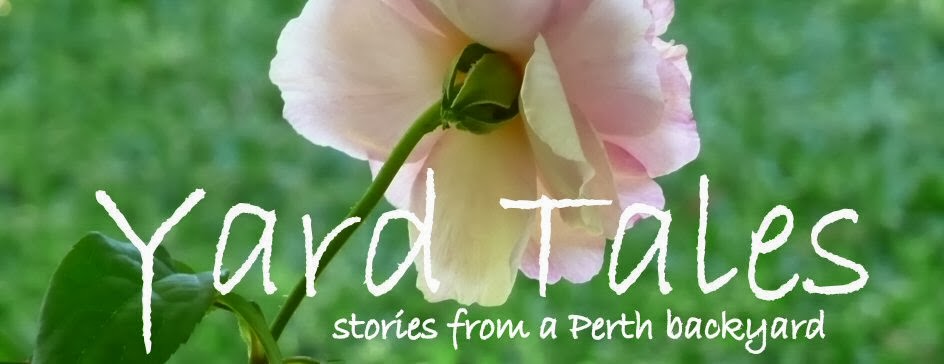Let
off the fireworks! Today marks 7 years since I moved into this house and
inherited a garden that was an almost blank canvas. And what better way to
celebrate than a post about the plants that were here all those years ago.
Hmmm, come to think of it there must be better ways, but for now…
Some
of the plants that had survived 5 years of neglect, 3 because the house was
empty and then 2 as a rental, surprised me.
And with rising water prices and the ever present threat of drought and
severe watering restrictions, having a garden that will survive and hopefully
sail through a dry summer is on my mind at least, and probably yours as well.
Here
is the list:
Natives
Australian
native plants have a reputation for being drought tolerant. This big eucalypt
is home to a small flock of pink and grey galahs that come in at dusk every
evening to roost.
There
are also several varieties of bottle brush and there was a Robin Gordon
grevillea which I had to take out because the garden area it was in had been
raised above the level of the rest of the garden and I wanted to bring it down
to one level. I planted a new one in the back yard but it was a cat-feeder. The
neighbouring cats hid beneath it and waited for birds to come in to feed and
then sprang out at them. It would be the stuff of bird-nightmares I’m sure. I
tried surrounding the plant with mesh but they dug under it, pushed it up and
crawled inside. Eventually I decided the death toll was too high and shovel
pruned it.
Lavender
There
were a lot of these and they were thriving.
Agapanthus and the
unknown iris
A
big clump of these beauties sits alongside the driveway. I love agapanthus with
their beautiful strappy leaves and pale purple flowers in early summer, they
always look good.
Along
with them is some sort of short clumping grassy evergreen iris. I have had a
shot at identifying it with the aid of my Botanica’s
Pocket Gardening Encyclopedia (it’s a little large for any pocket I have), and
I think it could be Iris unguicularis,
the Algerian Iris, which is from northern Africa. Its blue iris flowers often sit
well inside the foliage so it’s a little unfortunate for display.
These
all sit in a position where they get a full day’s sun in winter and morning sun
in summer with afternoon shade provided by the plane trees planted by my
Gardening Neighbour (thankyou, thankyou, thankyou). A bit of shade helps everything. The best time to plant a tree is 20 years ago,
they say, the second best is now.
Mandarin and Lemon
tree
It
was a surprise to find that citrus trees were drought tolerant but there they
were - a fruiting mandarin and lemon tree. The lemon tree
was from the rootstock and had big thorns and pithy fruit. I have replaced it
with a Washington navel now. The mandarin stays although I have trouble keeping
its foliage green. I suspect because it is too shaded –I planted a fig tree
close by which has grown to create too much shade in the cooler months. It
seems to also be growing on its own rootstock and has stayed a small tree to
around 5 foot. I reckon it’s an Emperor variety – it ripens a little later in
the season and has puffy skin. The fruit are a good size and flavour.
Poinsettia
Probably
bought as a Christmas decoration and then planted in the garden, it’s an
attractive small tree with the flowering bracts in autumn and early winter.
Birds and bees love it as well.
Bird of Paradise
Planted
under one of the plane trees and no doubt with heavy competition for all things
soil related is a huge clump of the bird of paradise plant (strelitzia). I
really like the bright and colourful flowers on this plant and its tropical
feel.
Roses
Roses
have only recently been promoted as being drought tolerant, probably since the
severe water restrictions in the eastern states a few summers ago when roses
were the survivors. There were some in this garden as well and I continue to
see roses in neglected gardens that thrive even in the heat. Are they drought
tolerant? Darn right!
Bamboo
There’s
a clumping bamboo in the back corner that was an original plant. I continued to
neglect it for the first summer I was here and I’ve got to say it didn’t look
good, but come the cooler temperatures in autumn and some rain it sprang back
like you wouldn’t believe.
Nandina
The
nandina, the sacred bamboo, with its lovely fern-like foliage doesn’t look like
the sort of plant that would be drought tolerant, but it sits in a very harsh
spot against the eastern fence and suffers only minor scorching. It appears in
the background of some of the rose shots. Here it is showing a bit of autumn
colour and its red berries.



















